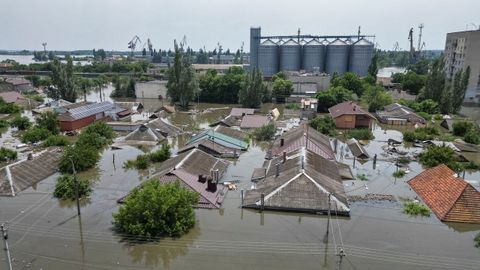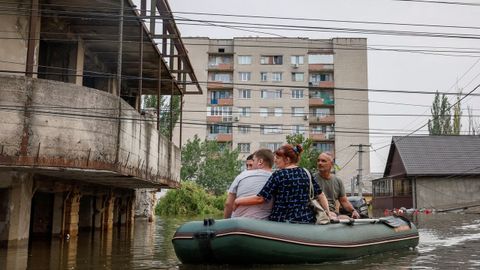Key allies in Kiev cautious, avoiding blaming Moscow until there are clear indications
In the midst of a new exchange of accusations about the authorship of the explosion that brought down the Ukrainian Kajovka dam, several Ukraine’s key allies have decided to be cautious before accusing Russia disaster, as evacuations continued Wednesday, with water levels rising further in the lower reaches of the Dnieper River and beginning to recede in Novaya Kakhovka, the town where the destroyed dam and hydroelectric plant were located.
Moscow continues to deny any involvement in the attack, which it blames on Kiev. During a telephone conversation with his Turkish counterpart Recep Tayyip Erdogan on Wednesday, President Vladimir Putin described the demolition of the dam as “barbaric”. According to the Kremlin, Putin said that Ukraine and its Western allies are “dangerously gambling with their escalation of hostilities, committing war crimes, openly using terrorist methods.”
Erdogan proposed to Putin to establish a commission of experts to investigate the authorship blowing up the Kajovka dam with the participation of its own countries, Ukraine and the UN, which indicates that Turkey is not clear that, as Kiev says, the disaster was the work of Russia.

A view of one of the flooded areas in the city of Kherson Vladyslav Smilianets | Reuters
Even Great Britain, a close ally of Zelenskiy, has so far not dared to hold Moscow responsible. “Attacks on civilian infrastructure are terrible (…), but it is too early for a definitive confirmation [que haya sido Rusia]”, said the British Prime Minister, Rishi Sunak. If this is confirmed, he added, the Moscow authorities “would sink even lower”.
Currently, US intelligence services are the only ones pointing to the Kremlin as responsible for the floods, according to NBC News. However, White House spokesman John Kirby acknowledged this Washington is not in a position to “say with certainty what happened” and looks forward to receiving more information.
The temporary leader of the occupied part of Kherson appointed by Moscow, Vladimir Saldo, assured that “the operational-tactical situation after the destruction of the hydroelectric power plant is in favor of the Russian army”, which, however, according to the Ukrainian agency Unian, are withdrawing from the fortified positions they held in the vanguard and march south. On Wednesday, the agency showed footage of Russian soldiers retreating with water above their knees.
CNN, citing Western officials, said the Ukrainian military would have to “postpone” its operations in the area as flooding damaged bridges and roads. Ukrainian reserve colonel Román Svitán pointed out via his Telegram channel that “Russian troops blew up the dam in order to make it as difficult as possible for the Ukrainian army to overcome the barrier represented by the Dnieper river”. According to him, “the Russians do not have enough soldiers to defend the entire bank of the river and are protecting themselves with floods against a possible landing of Ukrainian forces, at least for 10-15 days, until the water recedes”.

Evacuated population in Kherson region ALINA SMUTKO | Reuters
towed mines
After withdrawing from the city of Kherson last November, the Russian army is strengthening its defenses on the left bank with trenches and fortifications in order to prevent a possible Ukrainian advance towards Crimea. But Svitan warns that if the situation has now become difficult for the Ukrainians on that sector of the front, “and for the Russians because the water is flooding their trenches, making the fortifications useless, and the laid mines will be carried away by the current one.” They will also have to move their artillery positions.
Russia’s representative to the United Nations, Vasily Nebenzya, said on Tuesday that Ukraine “admitted its intention to blow up the Novaya Kakhovka dam” in December, citing a newspaper article. The Washington Post in which it is stated that the Ukrainian army even carried out attacks with Himars missiles on one of the locks of the dam.
The response of Ukraine’s representative at the UN, Sergiy Kislitsy, was that Russia was “putting the blame for its crimes on others” and reminded of Mariupol, Bucha, Izium and the Zaporizhia nuclear power plant. “Let me point that out Russia has controlled the dam and the entire Kakhovka power plant for over a year. It is physically impossible to somehow blow it up from the outside by bombing. The Russian occupiers mined it and blew it up,” Kislitsia said.
Telegram channels show a so far unconvincing video on the night from Monday to Tuesday in which a part of the dam allegedly explodes, partially collapses and is finally gradually destroyed by a strong push of the water flow. In his daily address on October 21, 2022, amid massive Russian attacks on Ukrainian power facilities, Zelensky accused Russian troops of blowing up the Kahovka dam and hydroelectric plant. Even then, he said he was afraid of a “large-scale catastrophe”.
More than 2,700 evacuees and around 20,000 homes without electricity in Ukraine
The Ukrainian authorities are working rapidly to mitigate the consequences of the spill of the dam at the Novaya Kakhovka hydroelectric plant in the south of the country. According to the Ukrainian government, more than 1,450 people have been evacuated from the worst-affected areas of the flood on the west bank of the Dnieper River, where the dam that divides Ukraine’s Kherson province was located. On the left bank, which was occupied by Russia, the Russian media are talking about 1,300 evacuees, according to Efe.
On the side of the river controlled by the Kiev government, water from the dam has already flooded around 100,000 hectares of farmland, according to Ukraine’s agriculture ministry, which warned of food security implications for one of Europe’s most productive regions.
In addition, the destruction of the dam disables the operation of at least 31 irrigation systems not only in the Kherson province, but also in the neighboring regions of Dnipropetrovsk and Zaporizhia. These systems made it possible to irrigate more than half a million hectares.
Damage to the electrical system
About 20,000 subscribers of Ukraine’s electricity system were left without power in southern Ukrainian territories controlled by Kiev after torrents of water released by a burst dam flooded 129 electrical substations, according to Ukraine’s energy ministry.
The disaster also affected the water supply system. Six water treatment infrastructures were flooded, according to Kherson city municipal authorities.
This was confirmed by Ukrainian President Volodymyr Zelensky “Hundreds of thousands of people are left without normal access to drinking water”. Faced with this situation, the Ukrainian government urgently approved a budget item for the construction of pipelines that bring drinking water to the regions that used the dam for supply in the south of the country. Thousands of animals also died in Kherson National Park and Novaya Kajovka Zoo, along with many pets.
Source: La Vozde Galicia
I am Amelia James, a passionate journalist with a deep-rooted interest in current affairs. I have more than five years of experience in the media industry, working both as an author and editor for 24 Instant News. My main focus lies in international news, particularly regional conflicts and political issues around the world.







